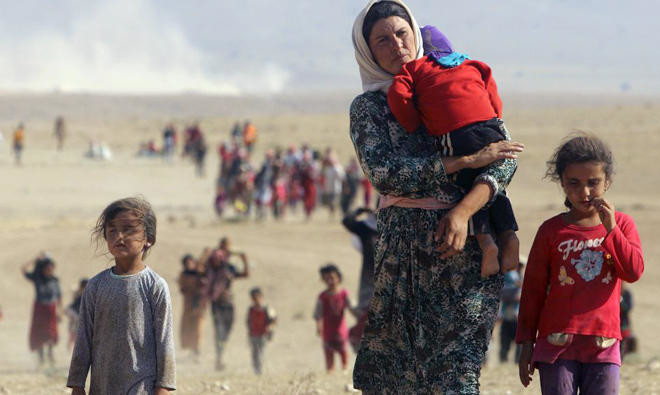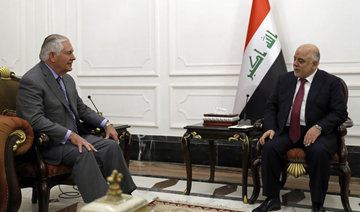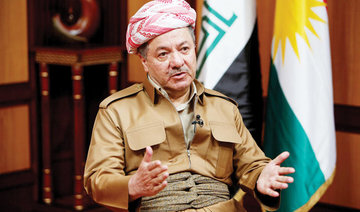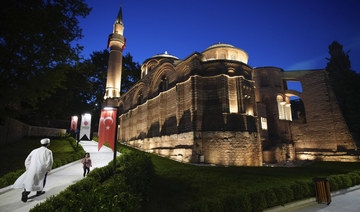BAGHDAD: Iraqi Sunni political parties have requested that the national parliamentary elections scheduled for May 15 2018 be postponed. Sunni politicians told Arab News the parties have stipulated that displaced people should have the chance to return to their homes before the elections are held.
Around 2 million Iraqis have been displaced from their homes over the last three years as Daesh took over much of the country followed by military operations launched by the government to retake those areas. Most of the displaced people are living mainly in Kurdistan, Baghdad and the south. Others are living in camps on the borders of their provinces.
“Elections must be held in all areas, with the participation of all Iraqis,” Kamil Al-Ghurairi, a Sunni lawmaker and senior political leader, told Arab News.
“How can elections be held while most of the displaced people of Mosul, Anbar, Salahudeen and Baghdad are still out of their areas? We have demanded the postponement of the election in order to ensure the participation of all,” he said.
While the majority of the displaced are Sunnis, they include Shiites, Turkmen, Christians, Shabaks and Yazidis. Hundreds of thousands of displaced Iraqis have been unable to return to their homes due to security and political issues, even though some of the areas in which they live were liberated more than two years ago, Sunni politicians told Arab News.
“If the government is serious, it can return those (displaced people) to their areas before the scheduled date for the election, but there are many agendas preventing it,” Bahaa Al-Deen Al-Naqshbandi, deputy head of the Iraqi Islamic Party, told Arab News.
“These agendas may aim to make demographic changes in these areas. There are many who do not want those (displaced people) to participate in the election,” Al-Naqshbandi, said. “They are seeking to ensure the participation of a component (Shiites or Kurds) and the exclusion of another one (Sunnis).”
The major concern for the Sunni parties requesting the postponement is the emergence of new Sunni factions in traditionally Sunni-dominated areas who are loyal to Shiite political forces. Those are the Sunni political figures and tribes who battled against Daesh under the umbrella of the Shiite-dominated Popular Mobilization Forces, who now control the liberated areas.
“What Sunni leaders do not explicitly declare is their fear of losing most of their current (Parliament) seats to new Sunni faces linked to the popular mob that fought and liberated the Sunni lands,” a senior Sunni leader told Arab News on condition of anonymity.
“The chances that the old Sunni political leaders and forces can win the elections are negligible, because most of them have failed to protect their people or relieve their suffering over recent years,” he added. “Most of them have not even visited the camps for the displaced or fought to defend their areas. Why should people vote for them?”
Iraq’s Electoral Commission began updating voter records and distributing voter cards earlier this week. Iraqi Prime Minister Haider Abadi and leading Shiite clerics Moqtada Sadr and Basheer Al-Najafi were among the first to receive the voter cards and call on their followers to take them.
In his weekly press conference on Tuesday, Abadi told reporters that the election would be held as scheduled and the view that the elections has to be postponed are “disrespectful.”
“Returning displaced people to their areas, is important,” he said. “There is an election and it’s important for them to go back to their homes to participate in it.
“The government’s efforts are now focused on supporting their (return), by providing the necessary services and security and meeting their needs in these areas,” he continued.
“We have set deadlines for their return and, God willing, we will abide by them.”
Iraqi Sunni political parties request election postponement
Iraqi Sunni political parties request election postponement

Moroccans in pro-Palestinian march rally against Israel ties

- Rabat has officially denounced what it said were “flagrant violations of the provisions of international law” by Israel in its war against Hamas, but has not given any indication that normalization with Israel would be undone
- Israel has killed at least 35,456 people in Gaza, also mostly civilians, according to data provided by the Hamas-run territory’s health ministry
CASABLANCA, Morocco: Thousands of Moroccans demonstrated Sunday in Casablanca in support of the Palestinian people and against ties with Israel, an AFP journalist said, more than seven months into the Gaza war.
Protesters in Morocco’s commercial capital chanted “Freedom for Palestine,” “If we don’t speak out, who will?” and “No to normalization,” and many wore keffiyeh scarves or waved Palestinian flags.
The North African kingdom established diplomatic ties with Israel in late 2020 under the US-brokered Abraham Accords which saw similar moves by the United Arab Emirates and Bahrain.
Under the deal, the United States recognized Morocco’s claim to sovereignty over the disputed territory of Western Sahara.
Since the Israel-Hamas war in the Gaza Strip began on October 7, large-scale demonstrations in Morocco have called for the abrogation of the normalization accord.
On Sunday, the demonstrators marched through central Casablanca in a protest called by a grouping of leftist parties and Islamist movements.
“I cannot remain indifferent and silent in the face of what is happening to the Palestinians who are being killed on a daily basis,” demonstrator Zahra Bensoukar, 43, told AFP.
Idriss Amer, 48, said he was protesting “in solidarity with the Palestinian people, against the Zionist massacre in Gaza and against normalization” of ties with Israel.
Rabat has officially denounced what it said were “flagrant violations of the provisions of international law” by Israel in its war against Hamas, but has not given any indication that normalization with Israel would be undone.
The Gaza war broke out after Hamas on October 7 launched an unprecedented attack on Israel which resulted in the deaths of more than 1,170 people, mostly civilians, according to an AFP tally based on Israeli official figures.
Israel’s retaliatory offensive has killed at least 35,456 people in Gaza, also mostly civilians, according to data provided by the Hamas-run territory’s health ministry.
Hamas also took about 250 hostages on October 7, of whom 124 remain held in Gaza including 37 the Israeli military says are dead.
What do we know so far about the mysterious crash of the helicopter carrying Iran’s president?

- Initially, Interior Minister Ahmad Vahidi said the helicopter “was forced to make a hard landing due to the bad weather and fog”
BEIRUT: The apparent crash of a helicopter carrying Iran’s president and foreign minister on Sunday sent shock waves around the region.
Details remained scant in the hours after the incident, and it was unclear if Iranian President Ebrahim Raisi and the other officials had survived.
Here’s what we know so far.
WHO WAS ON BOARD THE HELICOPTER AND WHERE WERE THEY GOING?
The helicopter was carrying Iranian President Ebrahim Raisi, the country’s Foreign Minister Hossein Amirabdollahian, the governor of Iran’s East Azerbaijan province and other officials and bodyguards, according to the state-run IRNA news agency. Raisi was returning from a trip to Iran’s border with Azerbaijan earlier Sunday to inaugurate a dam with Azerbaijan’s President Ilham Aliyev, the news agency said.
WHERE AND HOW DID THE HELICOPTER GO DOWN?
The helicopter apparently crashed or made an emergency landing in the Dizmar forest between the cities of Varzaqan and Jolfa in Iran’s East Azerbaijan province, near its border with Azerbaijan, under circumstances that remain unclear. Initially, Interior Minister Ahmad Vahidi said the helicopter “was forced to make a hard landing due to the bad weather and fog.”
WHAT IS THE STATUS OF THE SEARCH OPERATIONS?
Iranian officials have said the mountainous, forested terrain and heavy fog impeded search-and-rescue operations. The president of the Iranian Red Crescent Society, Pir-Hossein Koulivand, said 40 search teams were on the ground in the area despite “challenging weather conditions.” The search is being done by teams on the ground, as “the weather conditions have made it impossible to conduct aerial searches” via drones, Koulivand said, according to IRNA.
IF RAISI DIED IN THE CRASH, HOW MIGHT THIS IMPACT IRAN?
Raisi is seen as a protégé to Iran’s supreme leader Ayatollah Ali Khamenei and a potential successor for his position within the country’s Shiite theocracy. Under the Iranian constitution, if he died, the country’s first vice president, Mohammad Mokhber, would become president. Khamenei has publicly assured Iranians that there would be “no disruption to the operations of the country” as a result of the crash.
WHAT HAS THE INTERNATIONAL REACTION BEEN?
Countries including Russia, Iraq and Qatar have made formal statements of concern about Raisi’s fate and offered to assist in the search operations.
Azerbaijani President Aliyev said he was “deeply concerned” to hear of the incident, and affirmed that Azerbaijan was ready to provide any support necessary. Relations between the two countries have been chilly due to Azerbaijan’s diplomatic relations with Israel, Iran’s regional arch-enemy.
There was no immediate official reaction from Israel. Last month, following an Israeli strike on an Iranian consular building in Damascus that killed two Iranian generals, Tehran launched hundreds of missiles and drones at Israel. They were mostly shot down and tensions have apparently since subsided.
EU Red Sea mission says it defended 120 ships from Houthi attacks

- Human rights activist raps cases of prisoner fatalities as a result of torture in militia’s captivity
AL-MUKALLA, Yemen: The EU mission in the Red Sea, known as EUNAVFOR Aspides, said on Sunday that it had protected over 100 ships while sailing the critical trade channel and shot down more than a dozen Houthi missiles and drones in the last three months.
In a post on X marking three months since the start of its operation, the EU mission, which is now made up of five naval units and 1,000 personnel from 19 contributing nations, said that its forces had destroyed 12 drones, one drone boat, and four ballistic missiles fired by the Houthis from areas under their control in Yemen, as well as provided protection to 120 commercial ships since February.
“Great day for Freedom of Navigation, as 3 months have passed since the launch of ASPIDES. Three months of multiple challenges and great achievements. ASPIDES continues its mission in full compliance with international law, to ensure maritime security and seaborne trade,” EUNAVFOR Aspides said.
On Feb. 19, the EU announced the commencement of EUNAVFOR Aspides, a military operation in the Red Sea to defend international marine traffic against Houthi attacks.
At the same time, the Philippines Department of Migrant Workers said on Sunday that 23 of its citizens who were aboard the oil ship assaulted by Houthi militia in the Red Sea on Saturday were safe.
“The DMW is closely coordinating with international maritime authorities, shipping companies, and local manning agencies on the status of ships with Filipino seafarers traversing high-risk areas and war-like zones in the Red Sea and the Gulf of Aden,” the DMW said in a statement carried by the official Philippine News Agency.
For seven months, the Houthis have launched hundreds of ballistic missiles, drones, and drone boats against commercial and navy ships along international commerce lanes off Yemen, including the Red Sea.
The Houthis claim that their strikes are intended to push Israel to cease the war in Gaza and allow humanitarian supplies into the Palestinian territory.
Three civilian sailors, including two Filipinos, were killed in March after the Houthis launched a missile at their ship in the Red Sea.
Many international shipping companies directed their ships to avoid the Red Sea and other passages off Yemen, opting for longer and more costly routes through Africa.
Meanwhile, Yemen human rights activists have said that a man held by the Houthis during the last seven years died as a result of abuse in Houthi imprisonment, making him the latest victim of torture within Houthis detention facilities.
On Saturday, the Houthis told the family of Najeed Hassan Farea in Taiz through the Yemen Red Crescent that their son had died in their custody, but they did not explain how.
The Houthis abducted Farea in February 2017 after storming his village and home in the Al-Taziya district, preventing him from contacting his family and denying them information about where he was being detained.
Eshraq Al-Maqtari, a human rights activist in Taiz who reached Farea’s family, told Arab News that the Houthis cruelly tortured the man and that his family was stunned to hear of his death after years of information blackout since his detention.
“He was denied the right to communicate, to know his fate, and the right to healthcare, which appears to have caused his death,” she said, adding that since the start of the year, there have been three verified cases of prisoner fatalities as a result of torture in Houthi captivity.
10 years on, thousands forgotten in Syria desert camp

- Rukban camp was established in 2014 as desperate people fled Daesh and Syrian regime bombardment in hopes of crossing into Jordan
BEIRUT: In a no-man’s land on Syria’s border with Iraq and Jordan, thousands are stranded in an isolated camp, unable to return home after fleeing the regime and militants years ago.
When police defector Khaled arrived at Rukban, he had hoped to be back home within weeks — but eight years on, he is still stuck in the remote desert camp, sealed off from the rest of the country.
Damascus rarely lets aid in and neighboring countries have closed their borders to the area, which is protected from Syrian forces by a nearby US-led coalition base’s de-confliction zone.
“We are trapped between three countries,” said Khaled, 50, who only gave his first name due to security concerns.
“We can’t leave for (other areas of) Syria because we are wanted by the regime, and we can’t flee to Jordan or Iraq” because the borders are sealed, he added.
The camp was established in 2014, at the height of Syria’s ongoing war, as desperate people fled Daesh and regime bombardment in hopes of crossing into Jordan.
At its peak, it housed more than 100,000 people, but numbers have dwindled, especially after Jordan largely sealed its side of the border in 2016.
Many people have since returned to regime-held areas to escape hunger, poverty and a lack of medical care. The UN has also facilitated voluntary returns with the help of the Syrian Arab Red Crescent.
The last UN humanitarian convoy reached the camp in 2019, and the body described conditions there as “desperate” at the time.
Today, only about 8,000 residents remain, living in mud-brick houses, with food and basic supplies smuggled in at high prices.
Residents say even those meager supplies risk running dry as regime checkpoints blocked smuggling routes to the camp about a month ago.
Egyptian churches begin preparations to celebrate anniversary of Holy Family’s journey

CAIRO: Egypt’s Coptic community is preparing to celebrate the Feast of the Entry of the Holy Family into Egypt, starting on June 1.
Churches in the country have begun early preparations to welcome visitors, focusing on securing and preparing the sites along the journey the Holy Family is believed to have taken.
Robier El-Fares, an Egyptian Coptic researcher for Arab News, said: “The celebration of the journey of the Holy Family is a relatively new tradition that benefits religious tourism in Egypt. This comes after many years of neglecting the celebration.”
He added: “The route includes about 20 locations that represent the journey from Bethlehem in Palestine, fleeing the persecution of Herod who intended to kill Jesus Christ, and their subsequent travel to Egypt through plateaus and deserts.”
Father Augustinos Morris, priest of the Holy Family Church in Zeitoun, Cairo, for the Coptic Catholics, told Arab News: “Masses will be held at nine in the morning and six in the evening for all Copts who wish to participate. The readings are from Matthew 2, which discusses the flight into Egypt, and include a passage from the Old Testament in the Bible, amid the procedures followed in the holiday masses organised by the scout team.”
Father Matta Philip, priest of St. Mary’s Church in Maadi, Cairo, said: “The church is considered the first point of the Holy Family’s journey to Upper Egypt through a staircase, from there to a boat and then to Upper Egypt.”
He said: “Inside the Church of the Virgin Mary in Maadi, there is an icon depicting the life of the Virgin Mary, the altar vessels, and the Bible open to the verse — ‘Blessed be my people Egypt,’ — and a map of the family's route that starts from Arish and extends to the Monastery of Al-Muharraq.”
“Inside the church is the historic staircase that the Holy Family crossed, with an altar at its beginning where prayers are held,” he said. “From this staircase, the family headed to areas like Al-Bahnasa and Mount Al-Tair and other routes to the Monastery of Al-Muharraq, a journey that took about six months.”
Robier El-Fares said: “The known points of the Holy Family’s journey are 20, starting from Farma, located between the cities of Arish and Port Said, then to Tel Basta.”
“In Cairo, there are many points through which the Holy Family passed, including the area of Ain Shams, in addition to other areas in Maadi and Zeitoun, to start the points of Upper Egypt (southern Egypt), which are numerous including Gabal Al-Tair in Minya, and the Monastery of the Virgin Mary,” he said.




















